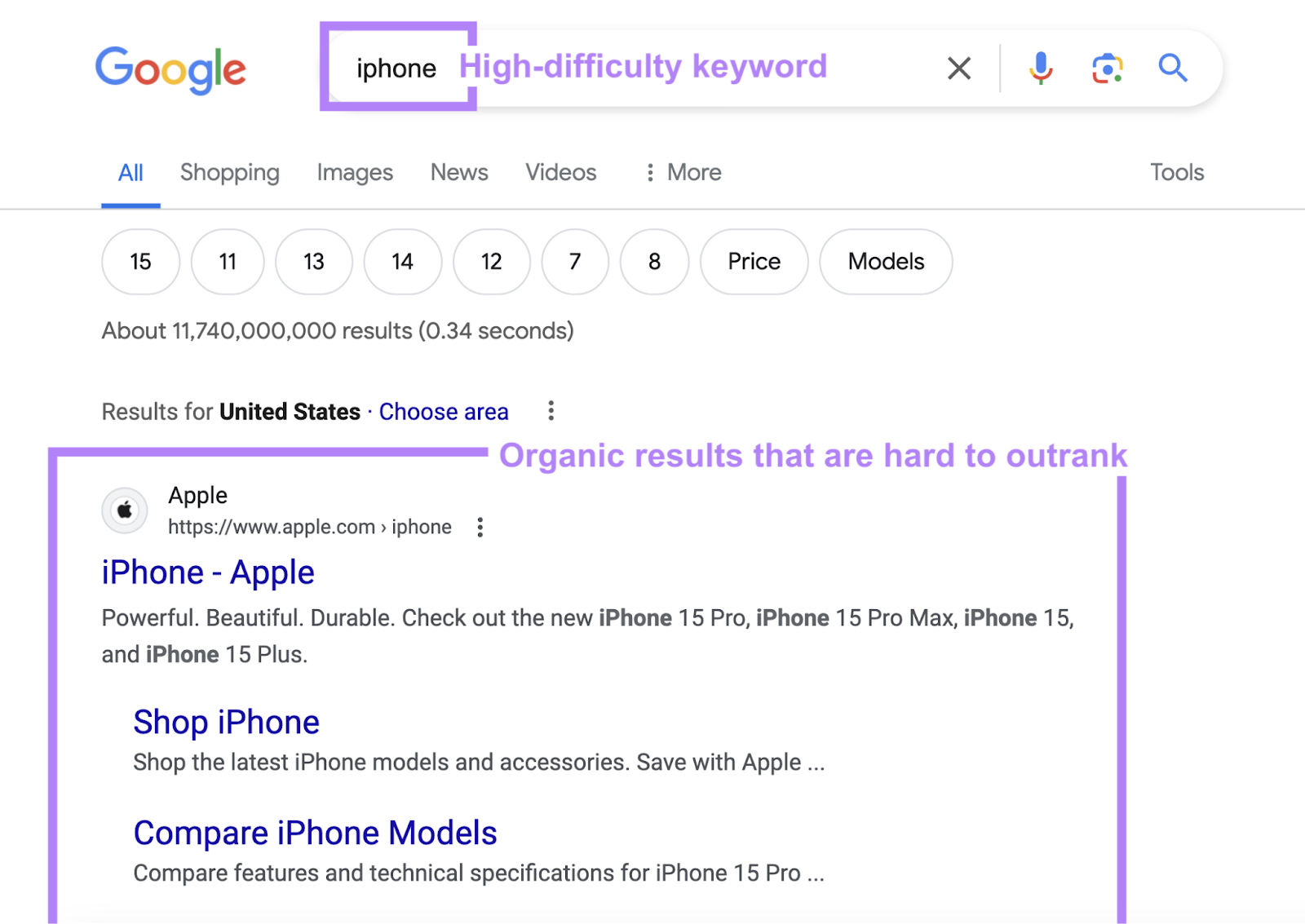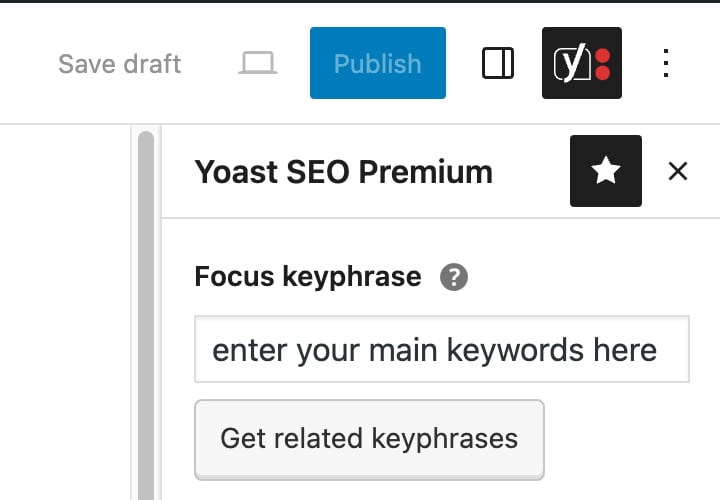keyword-difficulty-mean">What Does Keyword Difficulty Mean?
Keyword difficulty (or SEO difficulty) is a metric that estimates how hard it is to earn a prominent position in the search results for a given keyword.
For example, “iPhone” has a very high difficulty score because it’s extremely challenging to outrank highly relevant, high-quality search results from authoritative sites like Apple.
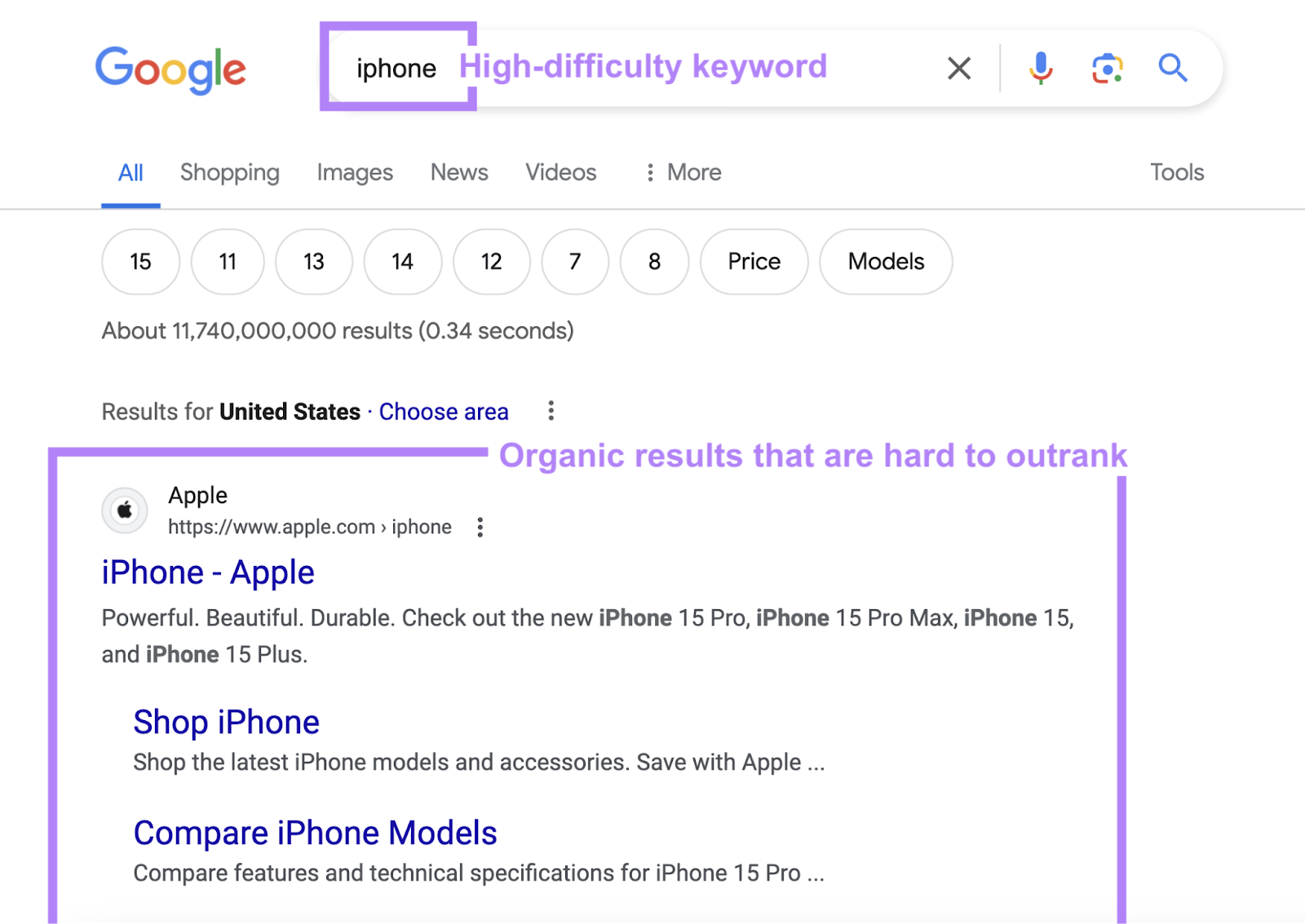
In Semrush, Keyword Difficulty (KD %) is expressed as a percentage. With a score of 100% being the hardest to rank for, and 0% the easiest.
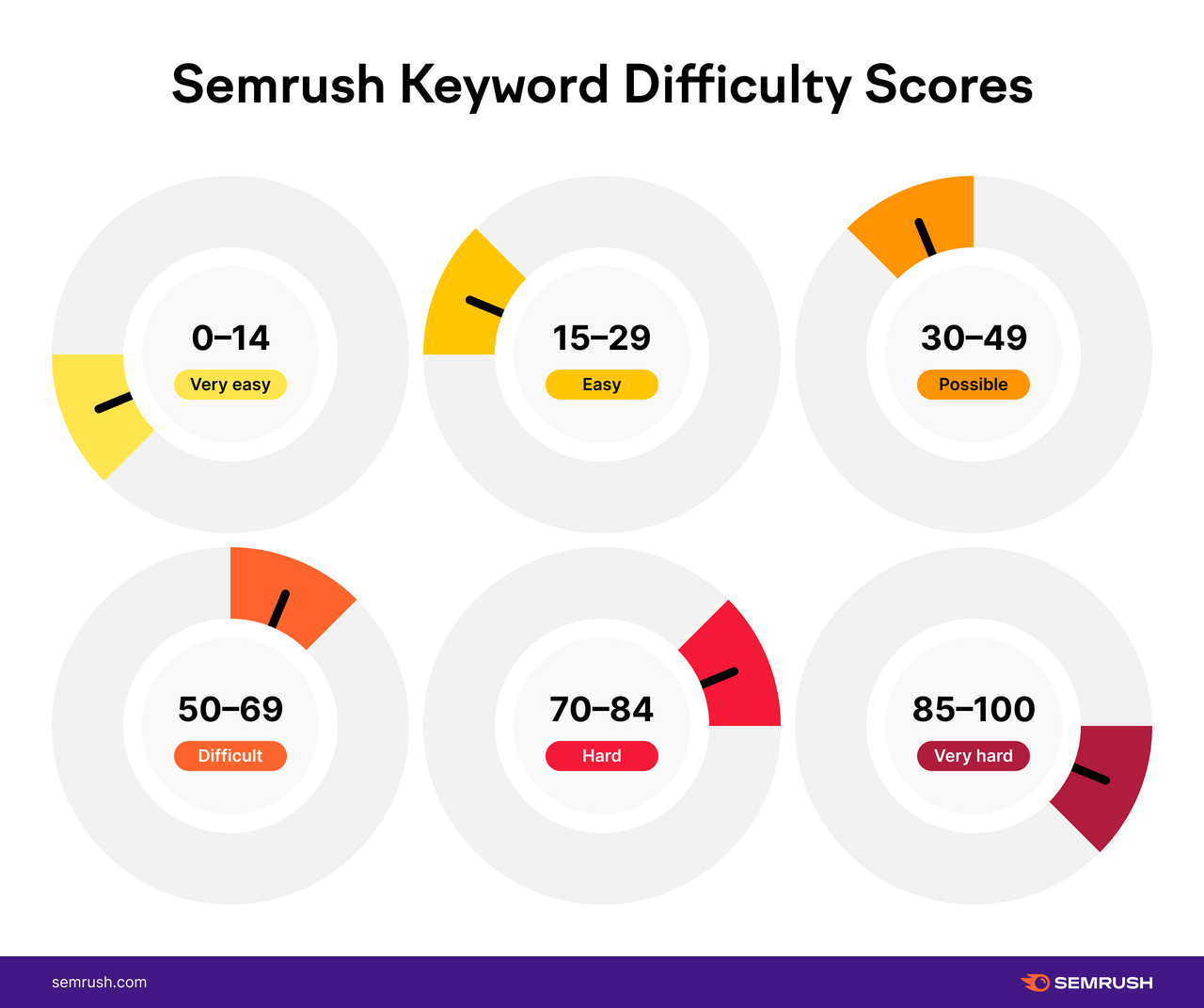
What Is Personal Keyword Difficulty?
In addition to a general Keyword Difficulty score, Semrush offers a personalized Personal Keyword Difficulty (PKD %) score. PKD considers your website’s authority and determines how challenging it would be for you to reach the top 10 search results for a particular keyword.
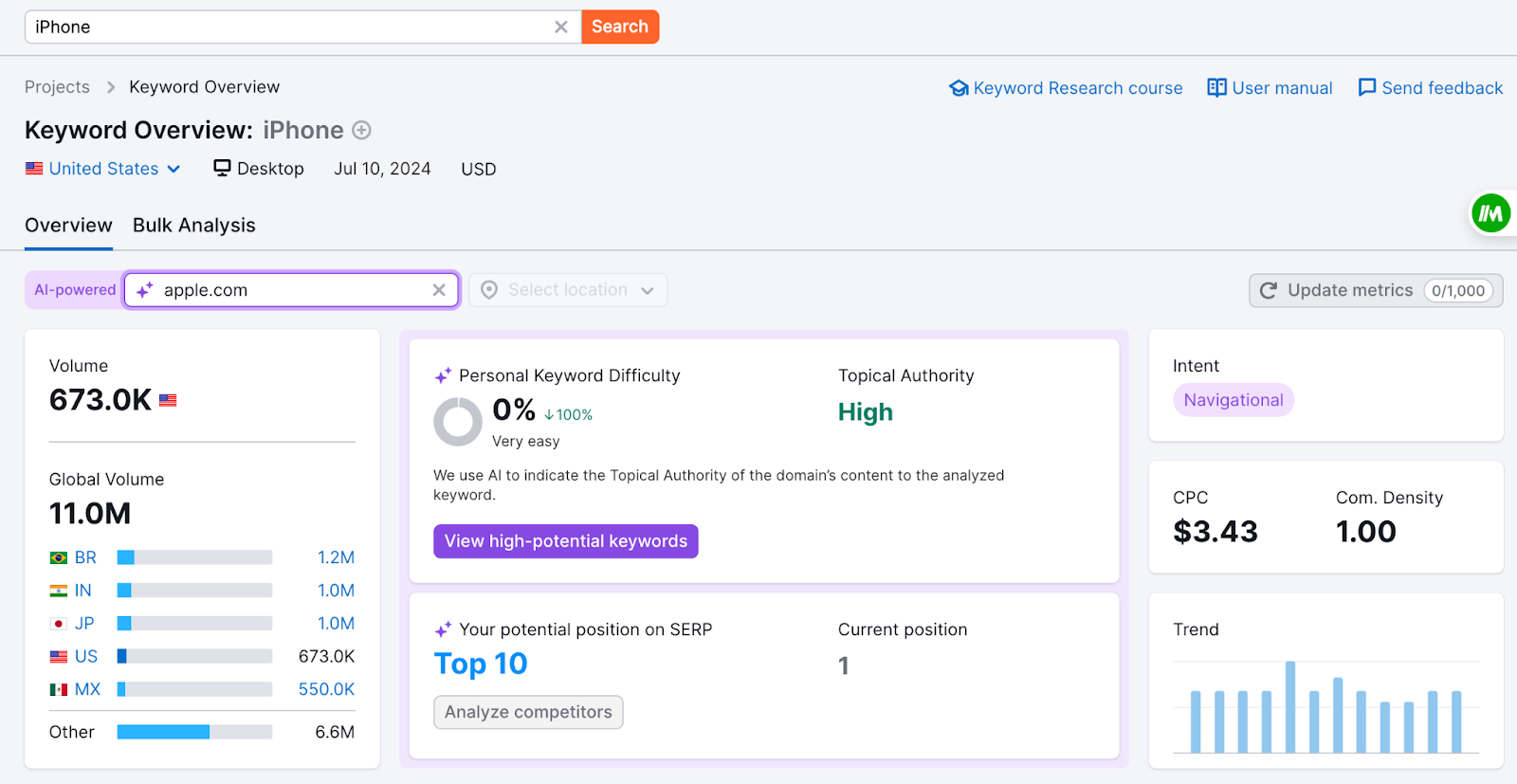
Knowing your PKD is more valuable than relying solely on the Keyword Difficulty score. PKD reveals keywords that might appear too competitive for your website based on the Keyword Difficulty score but are actually achievable.
Focusing on PKD opportunities can help you create a solid SEO strategy to increase your chances of ranking higher in search results.
Why Is Keyword Difficulty Important?
Keyword difficulty is important in search engine optimization (SEO) because it helps you identify search terms you have the potential to rank highly for in the organic listings of the search engine results pages (SERPs).
When you understand which keywords you can rank for, you can invest more resources into content that will likely generate more traffic from search engines to your website.
After all, higher rankings in the organic results usually lead to more clicks, which can translate to more website conversions and better business results.
By combining difficulty scores with other insights, you can select the best possible keywords for your content strategy.
What Affects Keyword Difficulty in SEO?
Both KD and PKD are based on analyzing Google’s top 10 organic results and various keyword characteristics.
Below, you’ll find a breakdown of six key factors.
1. Backlinks to Top-Ranking Sites
Backlinks are links from one website to another.
Google treats backlinks from high-authority sites as recommendations for the sites they are linking to. So, if you’re researching a specific keyword, and the top-ranking site for that keyword has a lot of backlinks, the keyword difficulty score for that keyword will likely be higher.
Semrush’s formula considers two main backlink metrics:
- The median number of referring domains: Generally, the more quality sites that link to a website, the more prominent and trustworthy it’s perceived to be. And the harder it’ll be to outrank.
- The median ratio of follow to nofollow links: Nofollow links are links the administrator has requested search engines to ignore for SEO purposes. So, sites with a low proportion of nofollow backlinks can be harder to outrank.
You can check these metrics yourself with Semrush’s Backlink Analytics tool.
Just enter the domain or URL you’re interested in and click “Analyze.”
Then, head to the “Backlinks” report to see the number of referring domains and the percentage of nofollow links.
Here’s what the Backlinks Analysis tool looks like in Semrush for Apple:
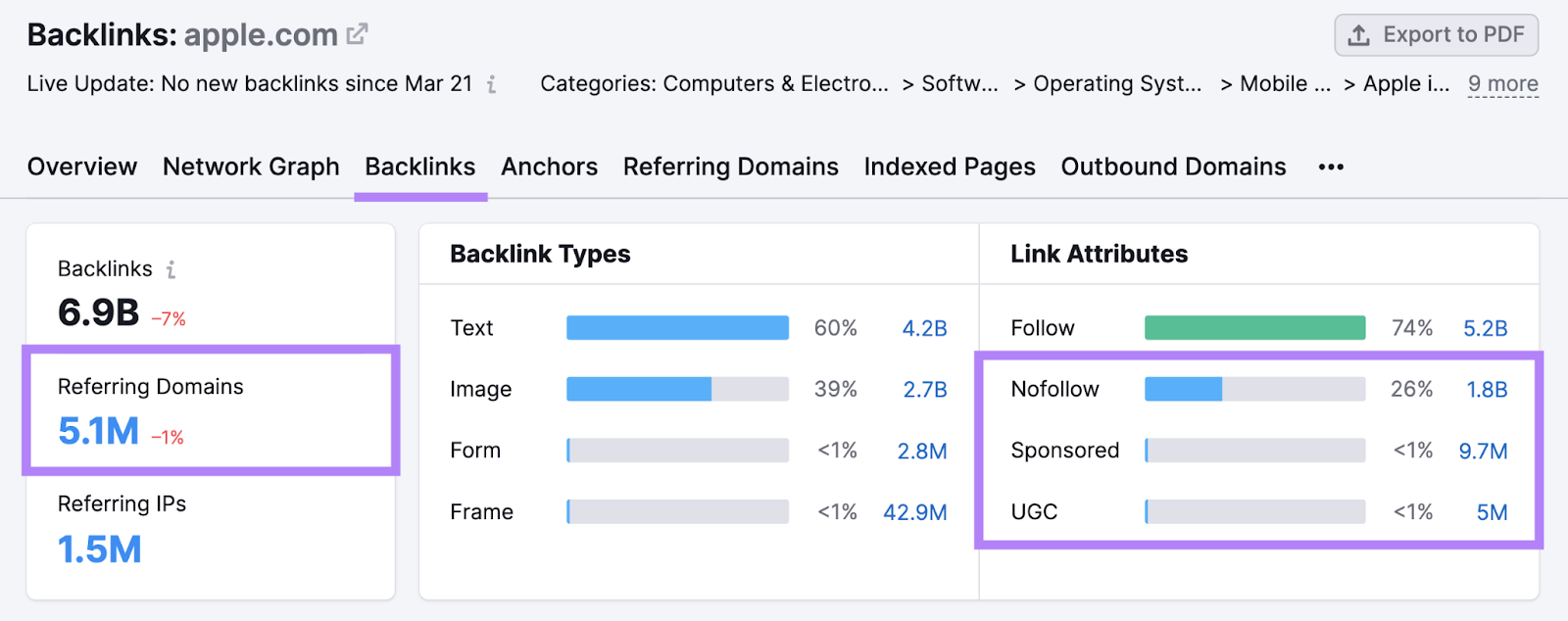
2. Authority Scores of Top-Ranking Sites
Backlinks also affect Authority Scores. Semrush’s Authority Score measures a website’s SEO ranking ability on a scale of 1-100. This score is based on three main factors:
- Link power: The quality and quantity of backlinks to the site
- Organic traffic: The estimated number of monthly organic clicks from search engines
- Natural profile: The prevalence of spam indicators in the site’s backlink profile (which you can learn more about in our guide to toxic backlinks)
The higher the top-ranking sites’ Authority Scores, the higher the keyword difficulty will be.
You can find your site’s Authority Score with the Backlink Analytics tool.
Enter your domain, then head to the “Overview” report.
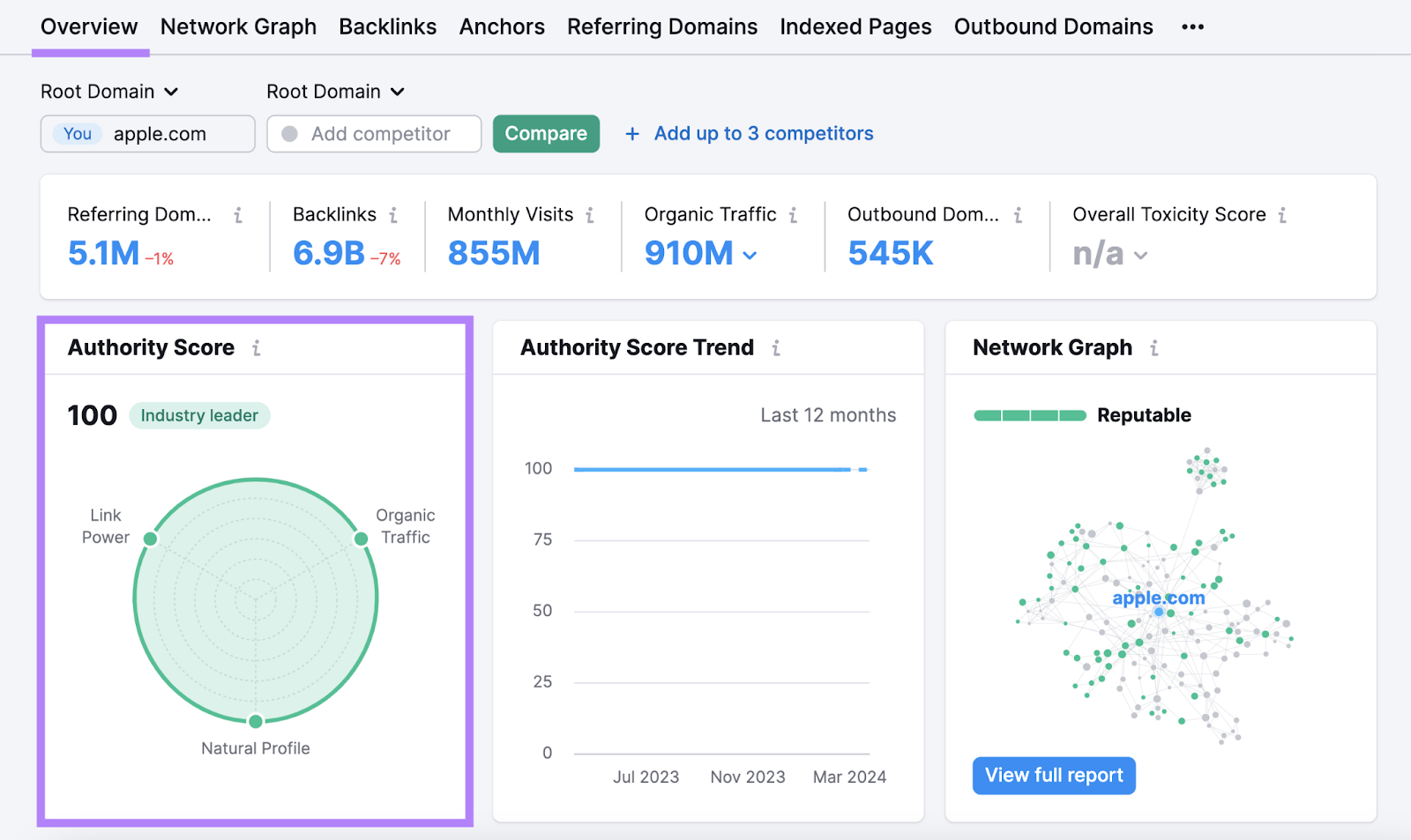
Then, add competitors to see how your Authority Scores compare.

3. Keyword Search Volume
Search volume refers to the average number of monthly searches for a keyword. Volumes tend to correlate strongly with keyword difficulty scores.
Why?
Higher-volume keywords have the potential to drive more traffic to a website. So, they tend to attract more competition.
You can find keywords, their search volumes, and their difficulty scores in Semrush’s Keyword Magic Tool.
Enter a relevant term to base your research around, choose your country, and click “Search.”
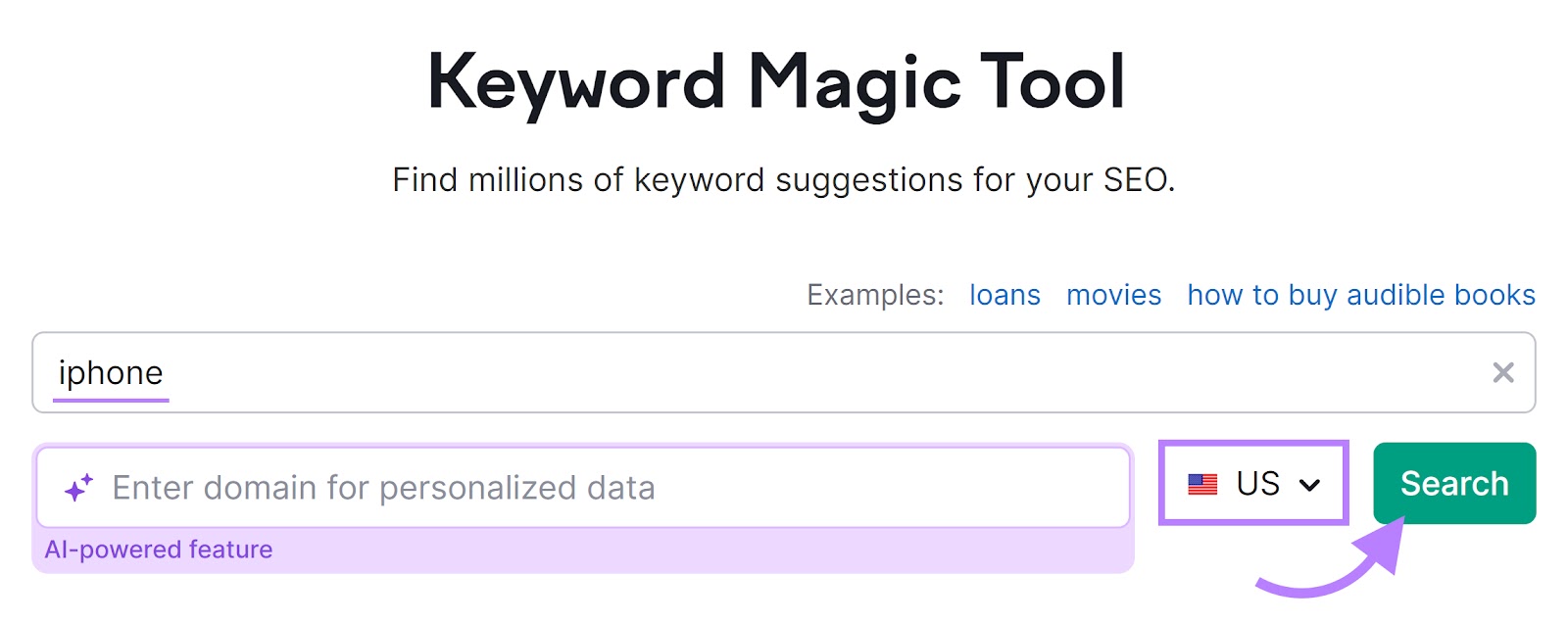
Then, refer to each keyword’s “Volume” and “KD%” columns.
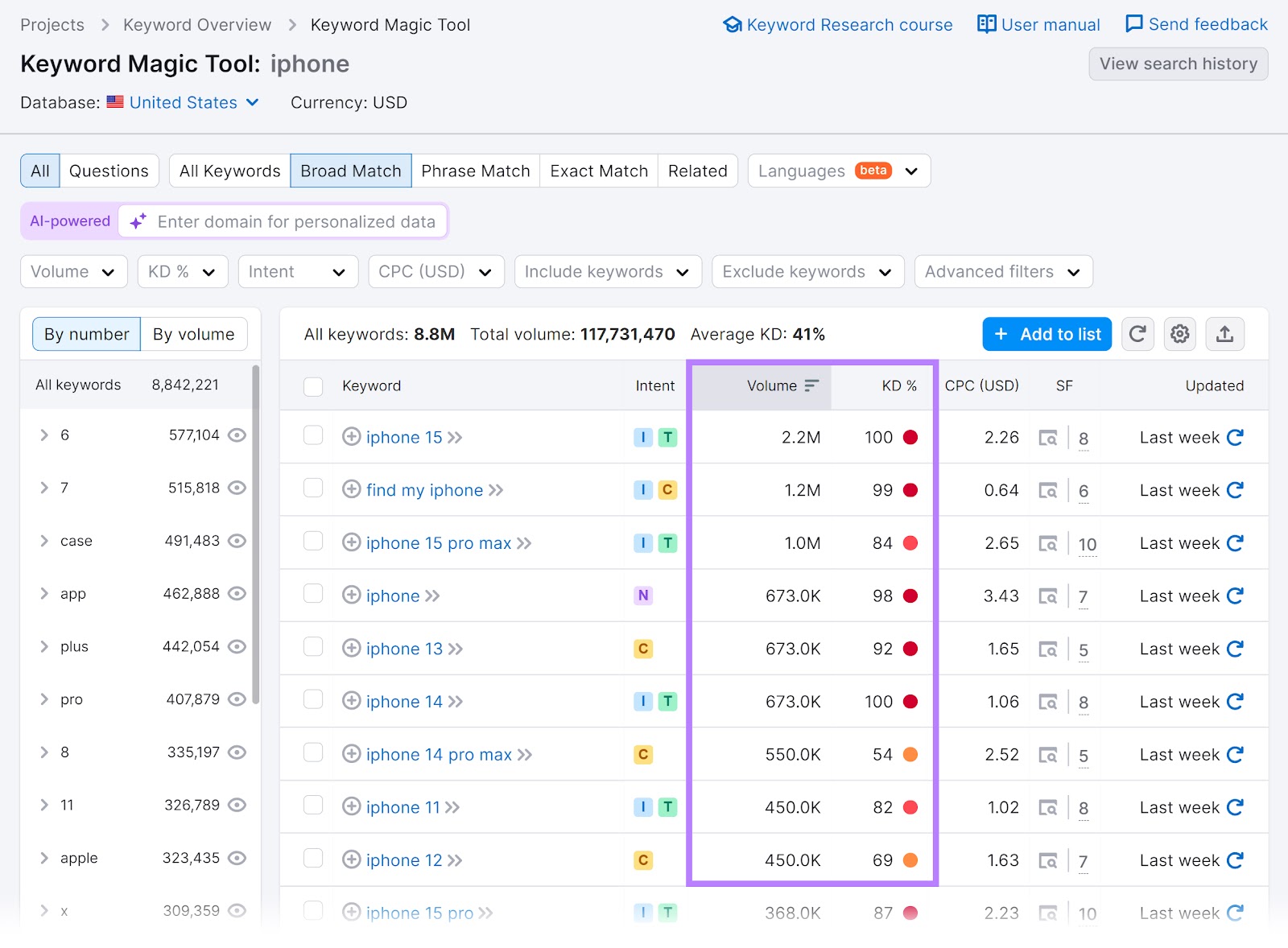
In the example below, keywords with search volumes of 100,001 or higher have an average Keyword Difficulty score of 76%.
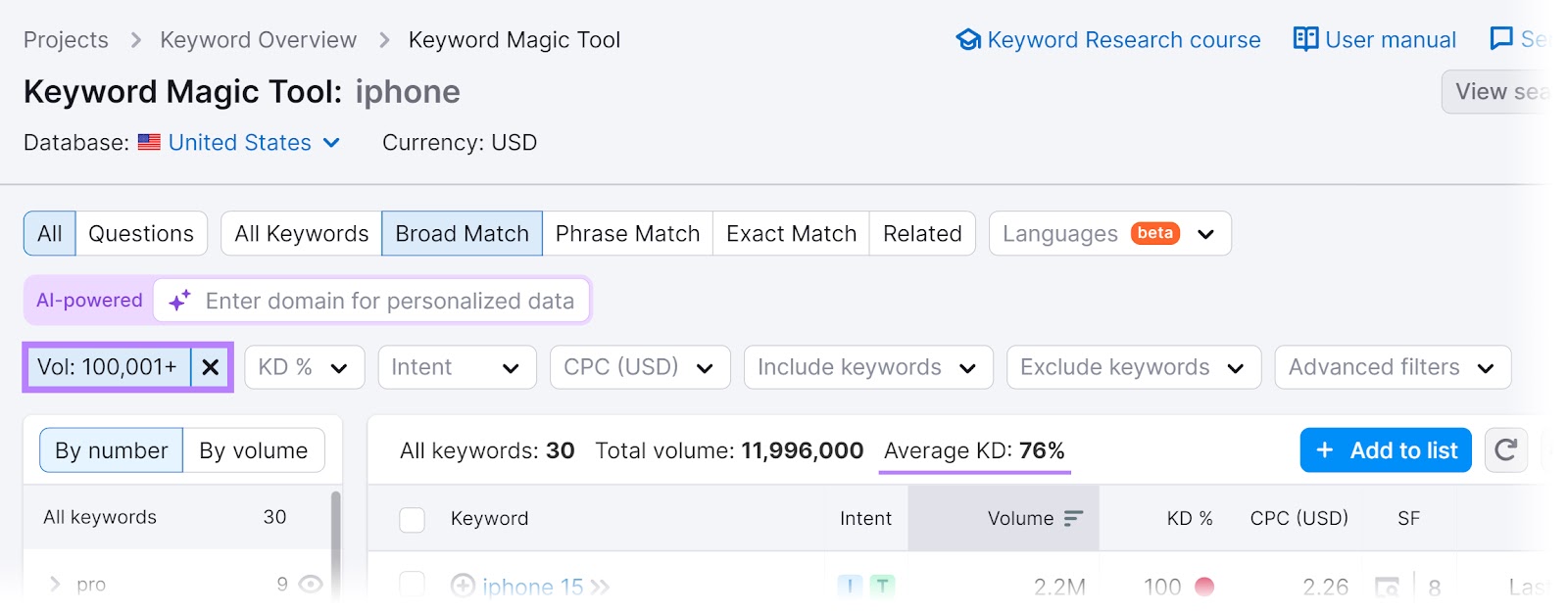
However, keywords with volumes from 11-100 have an average Keyword Difficulty score of 39%.
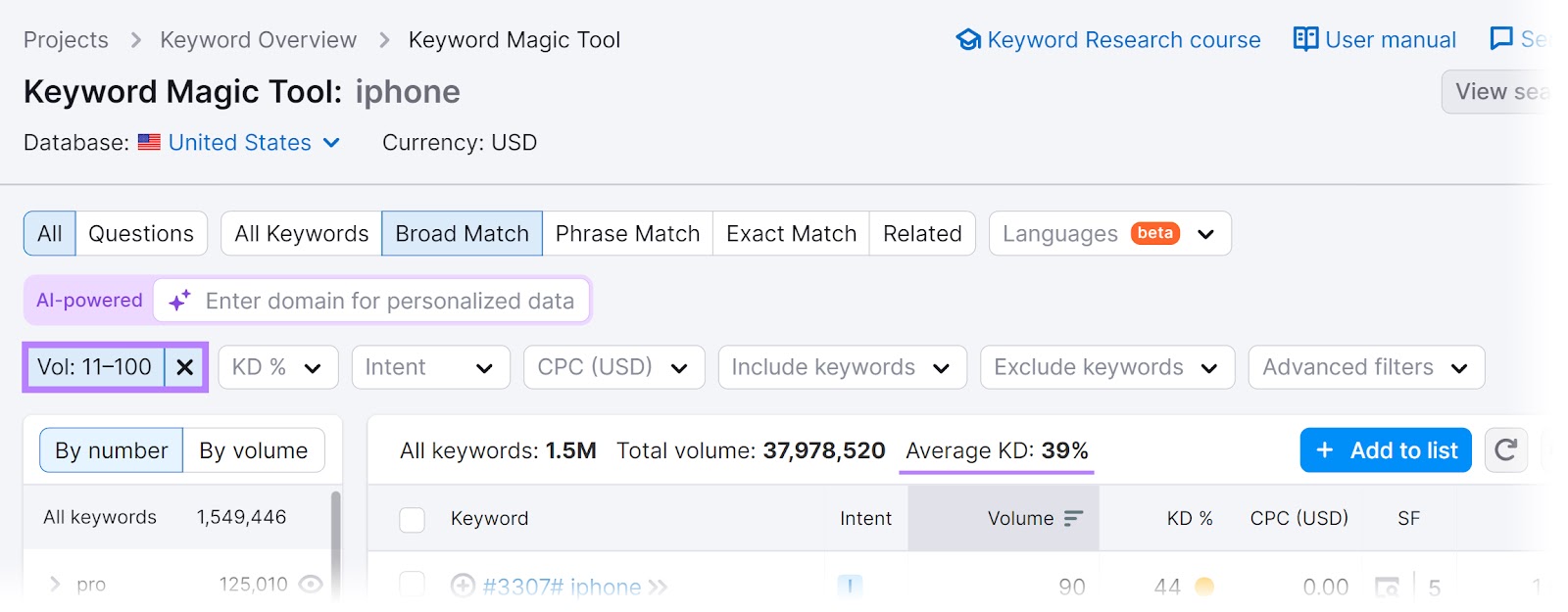
One of the best ways to maximize traffic is to target the highest-volume keywords that have achievable difficulty scores.
What’s achievable depends on your site’s status and content strategy. (More on that later.)
4. The Presence of SERP Features
SERP features are non-traditional search results that stand out and draw the user’s attention.
If a keyword triggers one or more of the features below, it’s sometimes harder for sites to earn organic clicks. So, that translates to a higher difficulty score.
- Featured snippet: A webpage excerpt that typically appears at the top of the SERP
- Instant answer: An answer that appears without a prominent link (e.g., a dictionary definition)
- Local pack: A block that includes map results and business listings
- Knowledge panel: A summary about a person, place, organization, or thing that appears on the right side of the SERP
- Top stories: A block that includes links to relevant news articles
- People also ask: A block featuring commonly asked questions and result snippets
- Sitelinks: Extra links to pages on a site (which appear below an otherwise standard result)
Here’s an example of what the SERP looks like for the high-difficulty keyword, “what is an iPhone.” You’ll see the featured snippet, People also ask, and first organic listing:
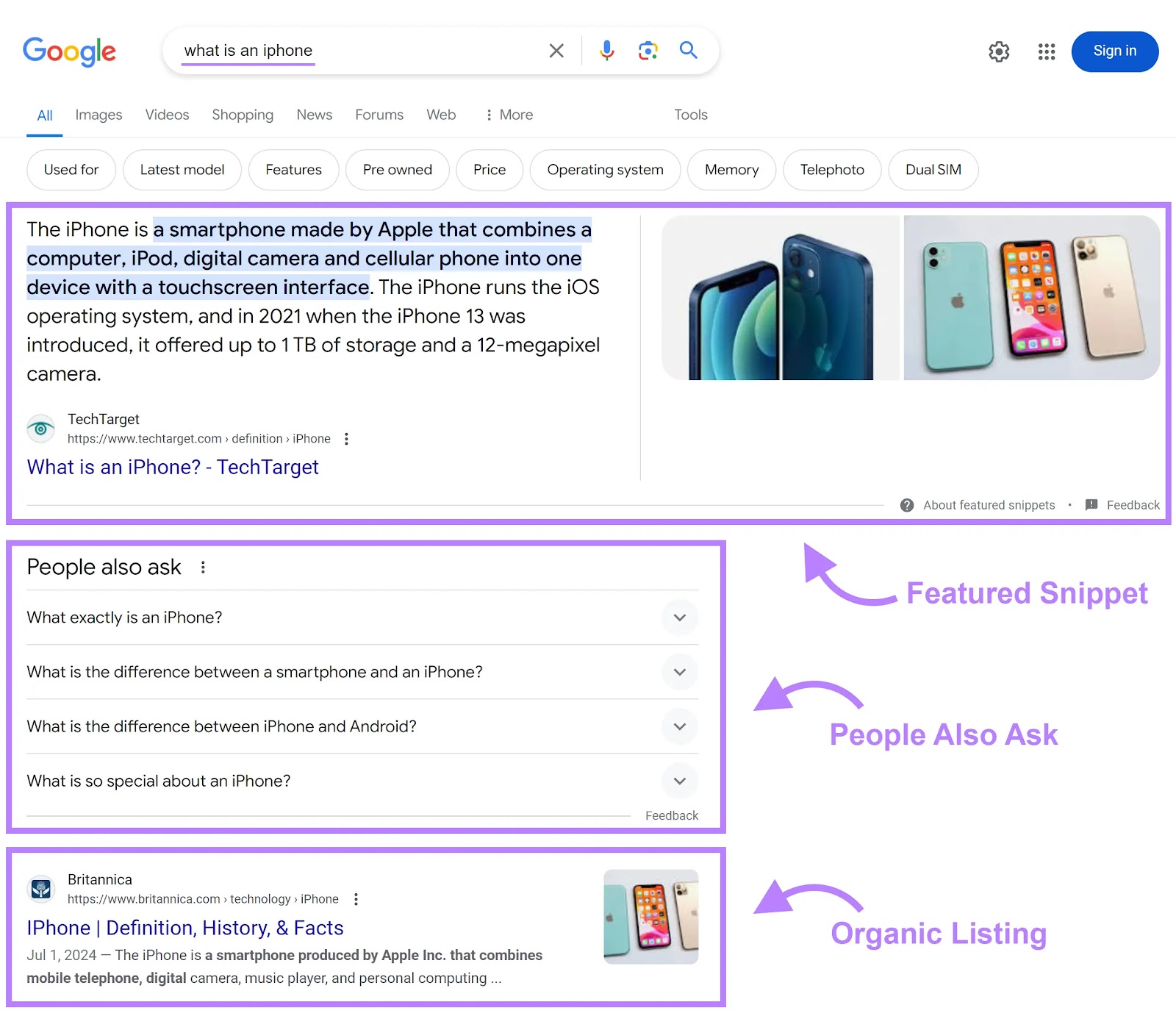
Conversely, the SEO keyword difficulty will be lower if no SERP features are triggered. Because there are no special elements to compete against.
When you do keyword research in the Keyword Magic Tool, you can see how many SERP features each keyword triggers. And discover which ones they are.
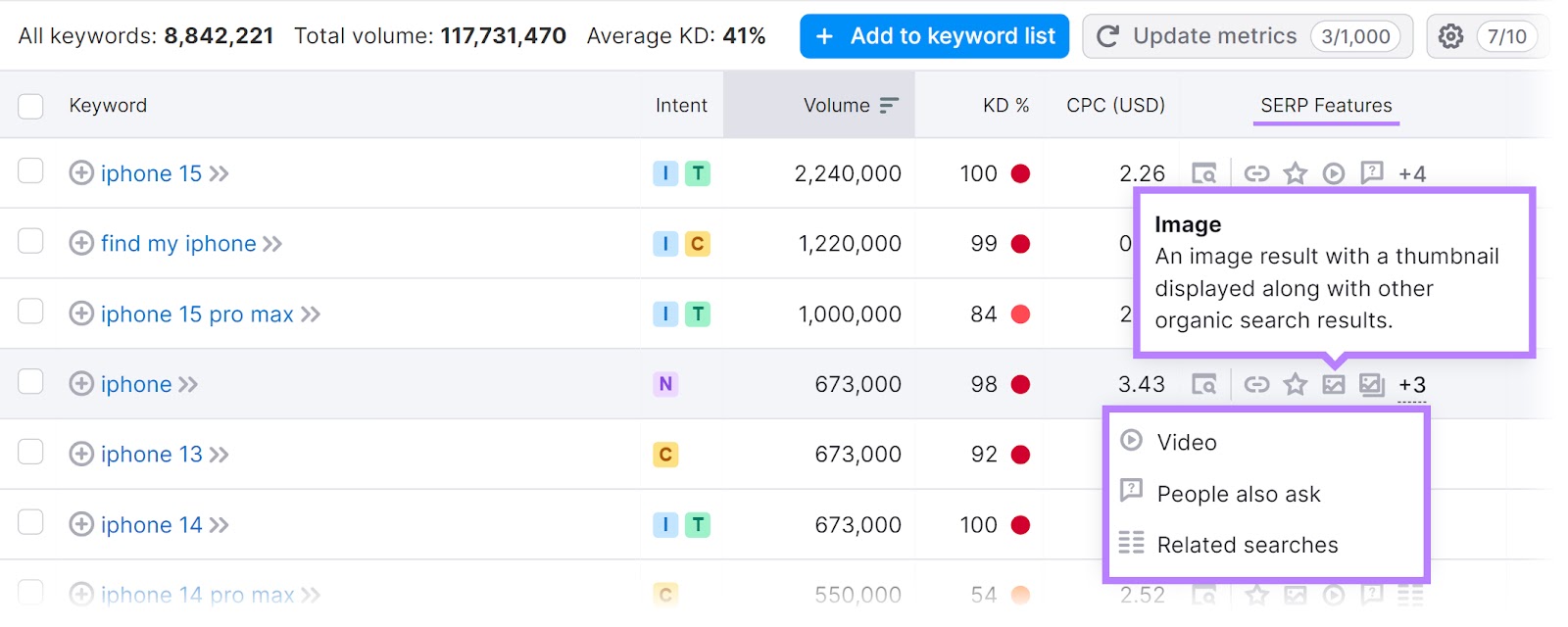
5. Branded Keywords
If a keyword includes a brand name (e.g., “iPhone”), its SEO difficulty score will usually be higher.
That’s because Google is likely to favor results from the brand’s own site. Making it harder for other sites to rank prominently.
For example, Apple dominates the “iPhone” SERP:
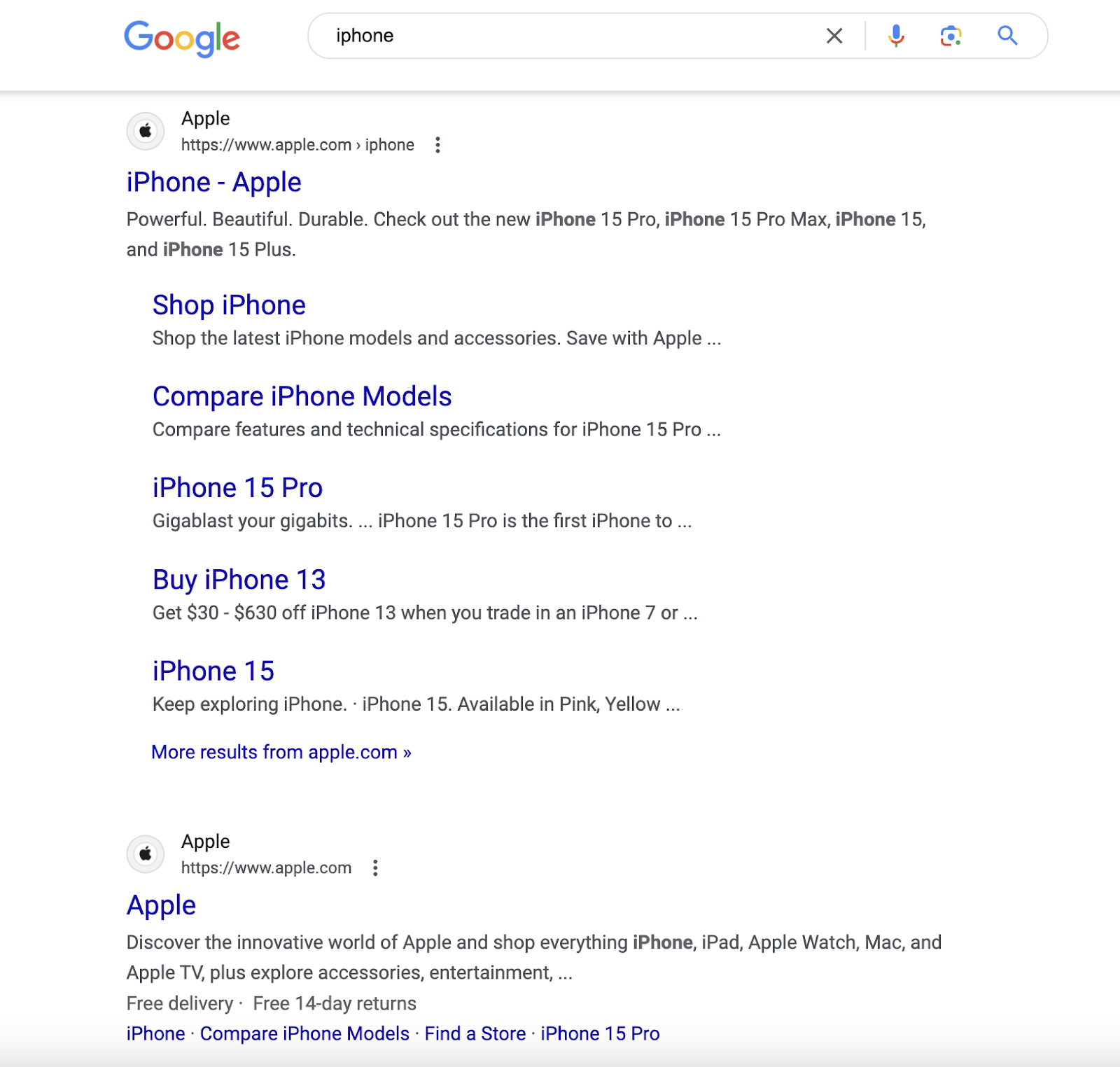
Of course, this means that it should be relatively easy to rank for your own branded keywords.
6. The Search Term’s Word Count
For our keyword difficulty metric, keywords with longer word counts usually have lower difficulty scores. This is because they tend to be long-tail keywords—highly specific keywords that often have lower search volumes and lower keyword competition levels.
For example, the latest data from our U.S. database shows that:
- “iPhone 15 Pro Max” has 71% difficulty and gets 823K searches/month
- “iPhone 15 Oro Max 256gb natural titanium” has 38% Keyword Difficulty score and gets 390 searches/month
Long-tail keywords typically correlate with high engagement and conversion rates. Because users have a clear idea of what they’re searching for.
So, long-tail keywords with low difficulty scores can be great keywords to target.
When you use the Keyword Magic Tool, you can find long-tail keywords specific to your business (which are often longer) using the suggested groups and subgroups on the left-hand side. For the term “iPhone,” it looks like this
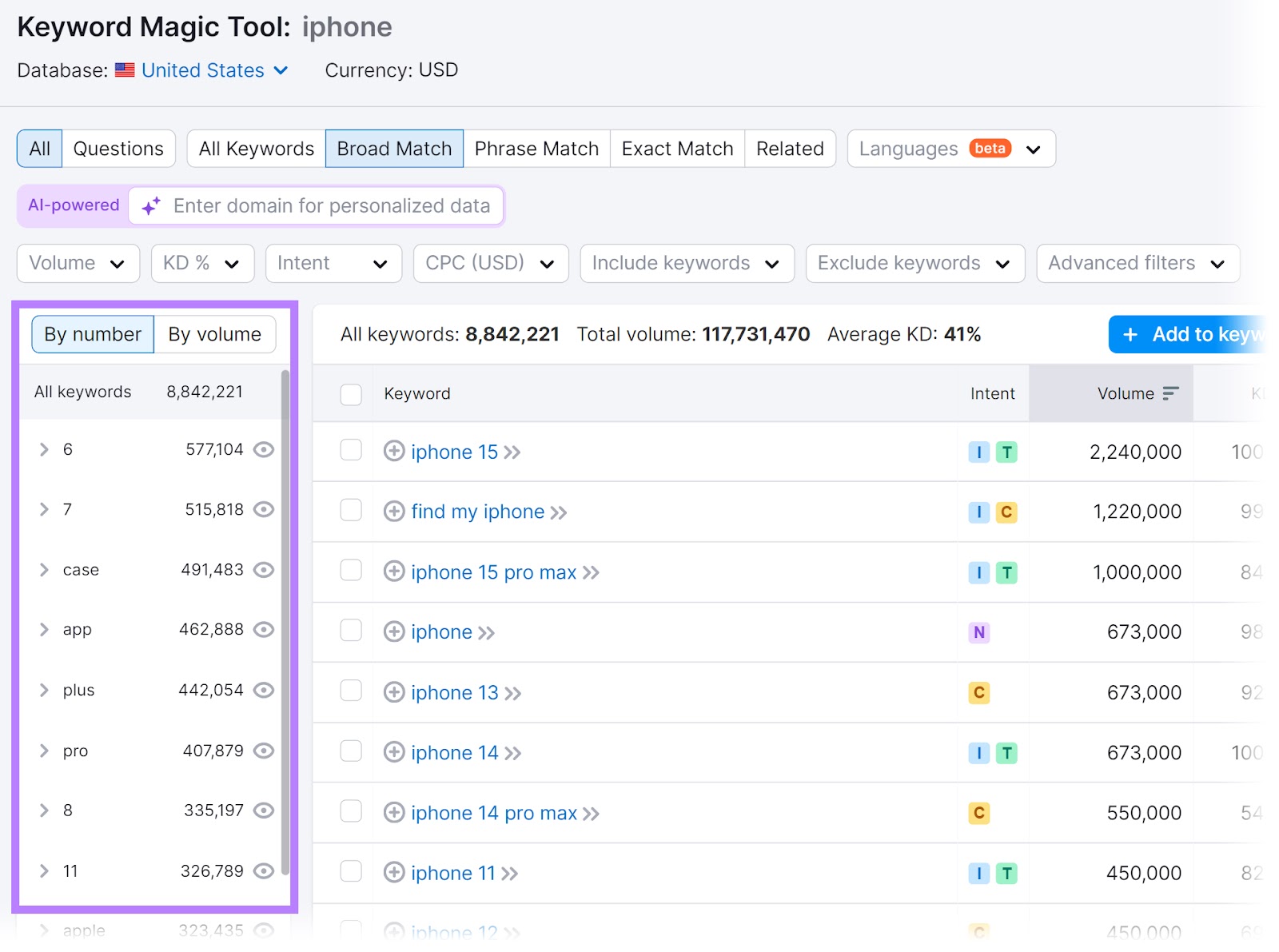
How to Check Keyword Difficulty
You can easily check keyword difficulty scores with Keyword Overview.
Just type your keyword(s) into the tool and you’ll see the score(s) in the dashboard.
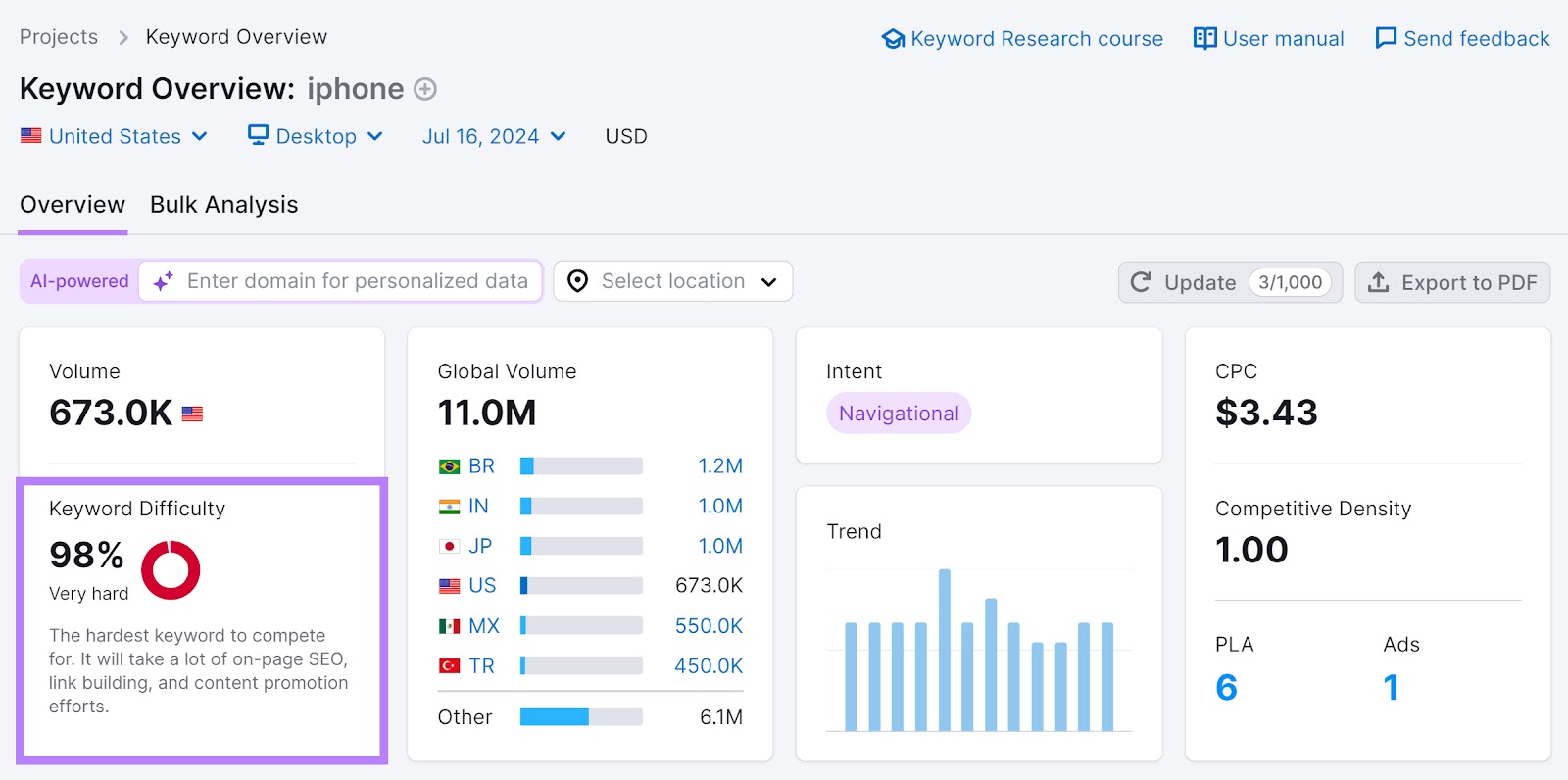
If you’re conducting keyword research, the Keyword Magic Tool displays each Keyword Difficulty score in the “KD %” column.
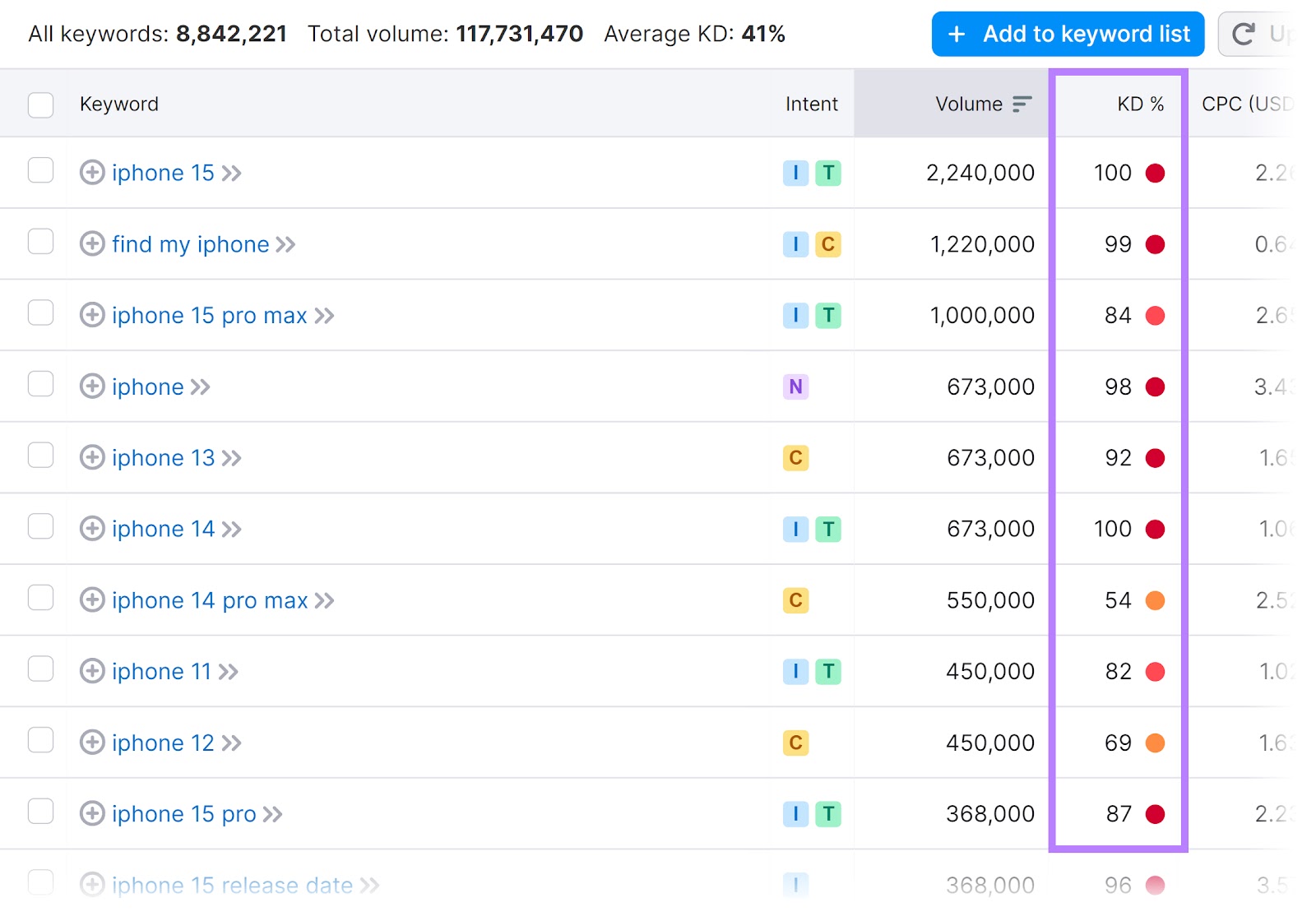
And this is how the scores break down:
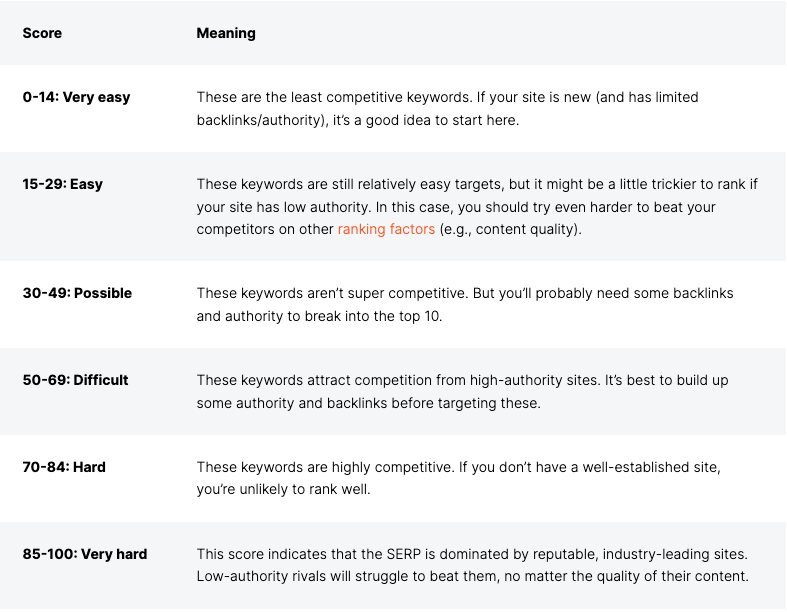
New Personal Keyword Difficulty (PKD)
Getting your PKD score for each keyword is easy. Enter your domain in the “AI-powered” search box in the Keyword Overview tool.
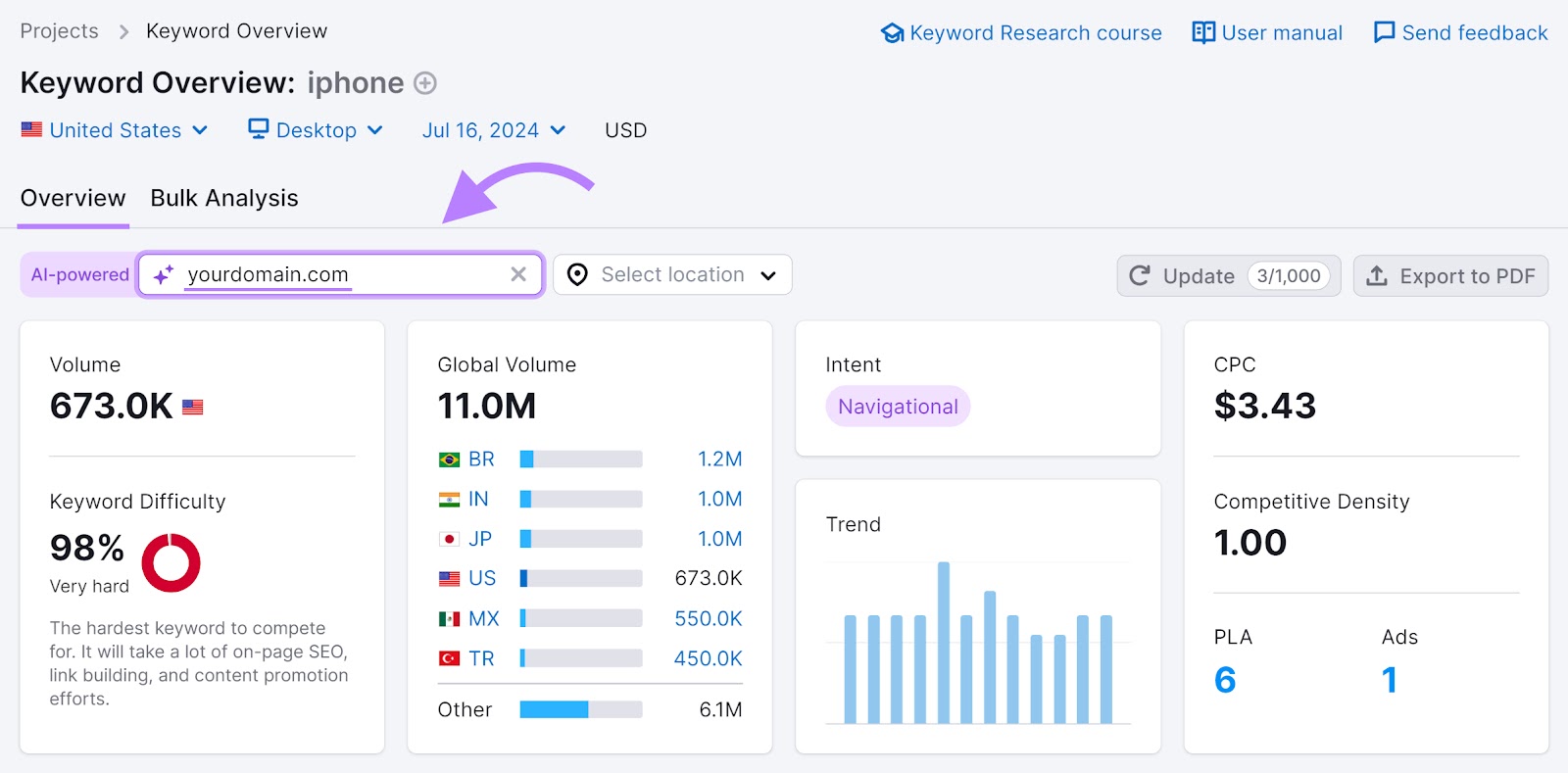
You’ll then see your PKD score for that specific keyword, along with the following valuable insights:
- Topical authority: Assesses your domain’s authority on specific topics, helping you identify areas for potential ranking success
- Potential SERP positions: Shows your current keyword rankings and forecasts potential improvements, aiding in SEO prioritization and goal-setting
- Current position: Shows your current keyword ranking in the SERPs
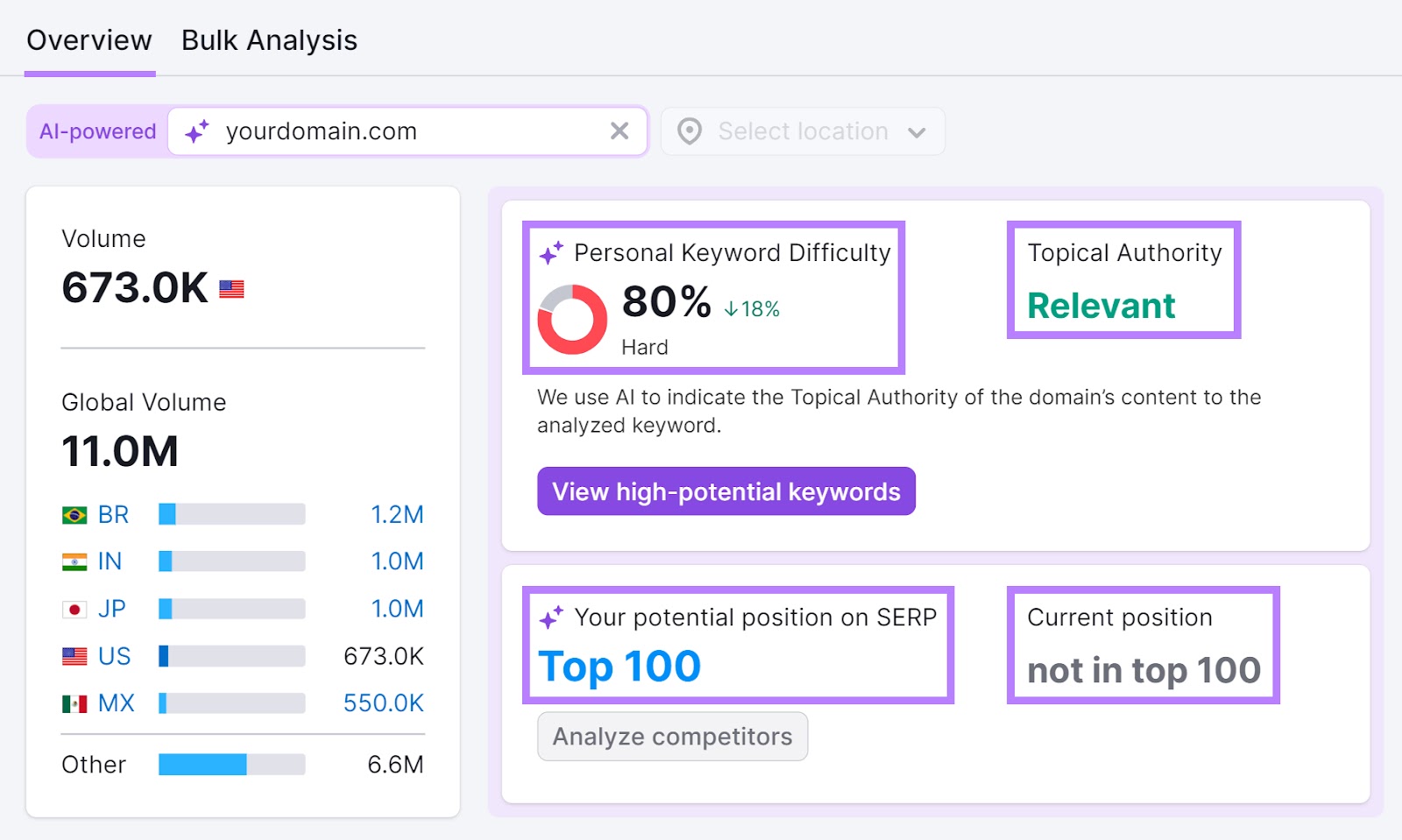
Further down the page, you’ll discover additional keyword options like “Keyword Variations” and “Questions,” each with its own PKD score. Considering your website’s specific ranking potential, these options give you more keywords to target.
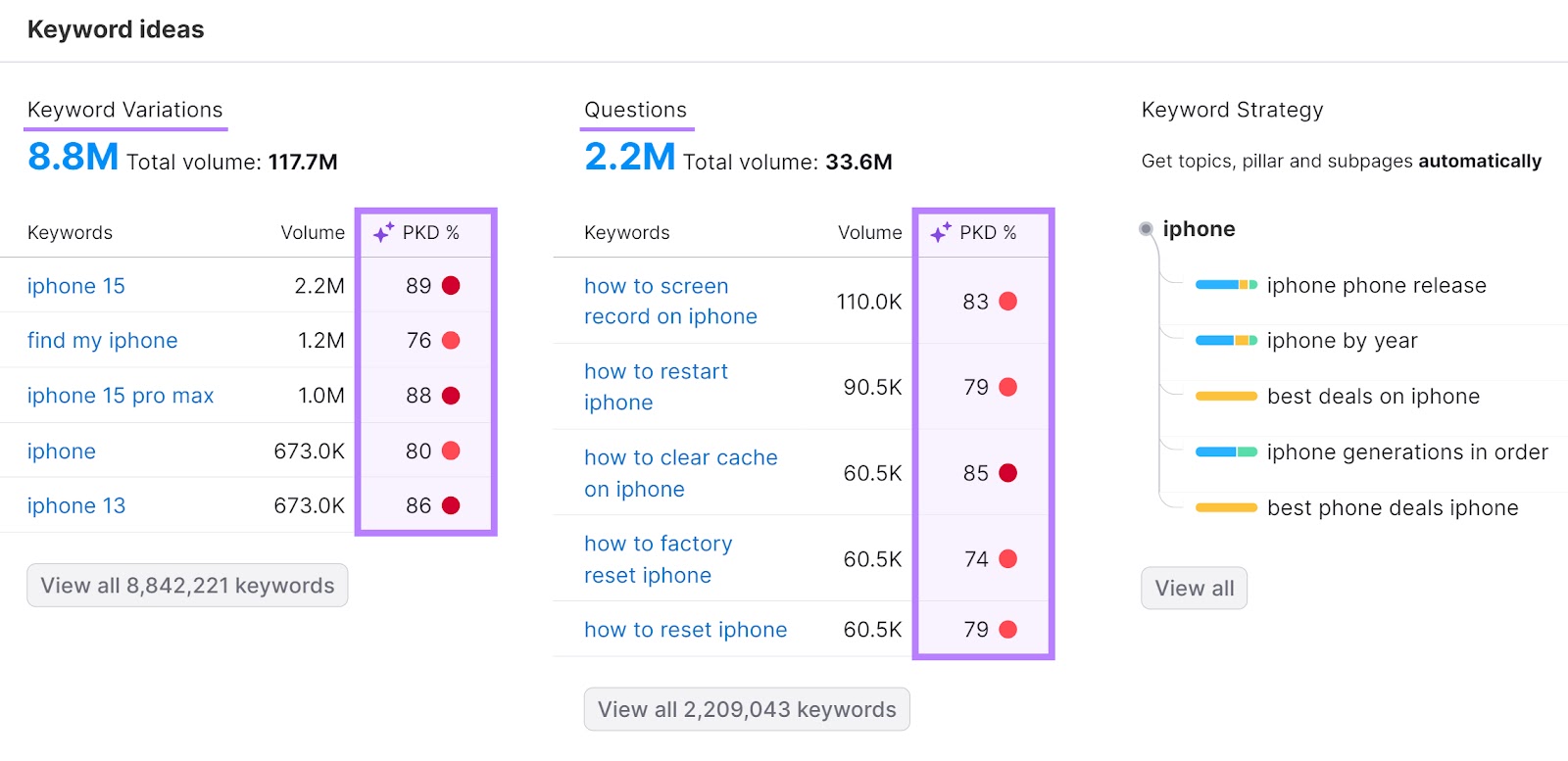
What’s a Good Keyword Difficulty Score to Target?
Knowing what keywords you can rank highly for is helpful when looking at your current performance.
You can quickly analyze your keywords and their difficulty scores in the Keyword Magic Tool.
Enter your seed keyword and your domain. And click “Search.”

Look at the “PKD%” and “KD%” columns.
Remember:
- KD% shows the general difficulty of ranking for that keyword across all websites
- PKD% shows the difficulty of ranking for that keyword specifically for your website, considering your domain’s authority and backlink profile
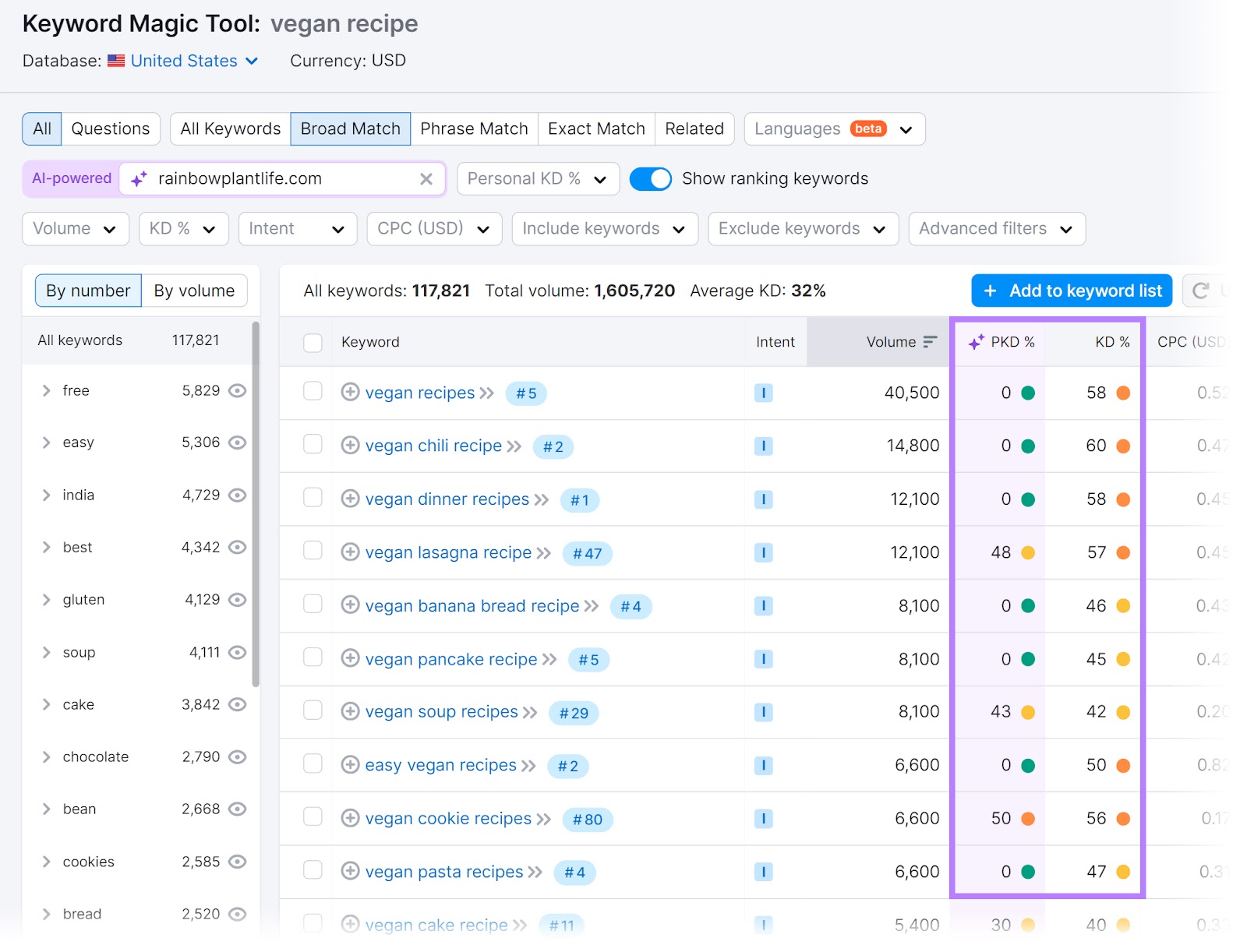
Look for keywords with a low “PKD%” but a higher “KD%” score.
Why?
This may indicate a golden opportunity. Although the keyword might seem competitive overall, your website has the potential to outperform others.
You also apply the “Personal KD%” filter and set it to “Possible” and the “KD” filter to “Difficult.” This will quickly narrow the list to keywords where your website can rank well.
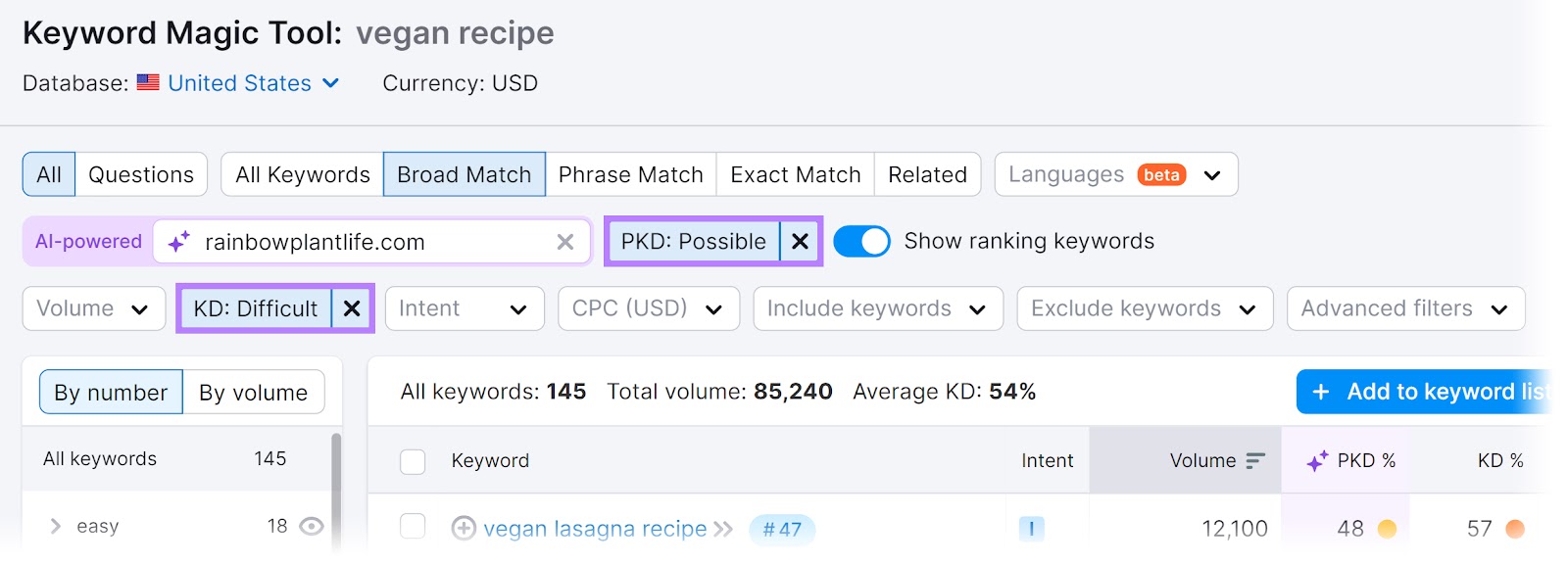
For example, the website rainbowplantlife.com creates content around vegan food.
By using the seed keyword “vegan recipe” and applying the filters mentioned above, there are 145 potential keywords they aren’t currently ranking for but for which their PKD indicates a high chance of success.

However, there’s no one-size-fits-all answer to “what’s a good keyword difficulty score.”
If you have a lower Authority Score and weaker backlinks than your competitors, you’ll find it hard to outrank them. So, you should probably focus on keywords with lower difficulty to start.
You can improve your competitiveness over time by:
- Doing link building (acquiring high-quality backlinks from reputable sites)
- Building out topic clusters (groups of content that center around a main topic) to establish authority around relevant topics
- Growing your organic traffic through lower-difficulty keywords
How to Create Rankable Content
No matter the keyword difficulty score, you must create quality content to earn a top ranking.
This is unique content that efficiently and effectively satisfies search intent (the user’s reason for searching).
You want to outshine all your competitors.
When you find keywords in the Keyword Magic Tool, you can easily click through to the SERP. And check out what you’re up against.
Just click the icon that looks like this:

![12 Web Design Best Practices & Guidelines for Usability in 2025 [+ Expert Tips]](https://bloggerseo.com.ng/wp-content/uploads/2024/11/12-web-design-best-practices-guidelines-for-usability-in-2025-expert-tips-150x58.png)

![Best Times to Post on YouTube in 2025 [Research]](https://bloggerseo.com.ng/wp-content/uploads/2024/11/best-times-to-post-on-youtube-in-2025-research-150x58.png)
